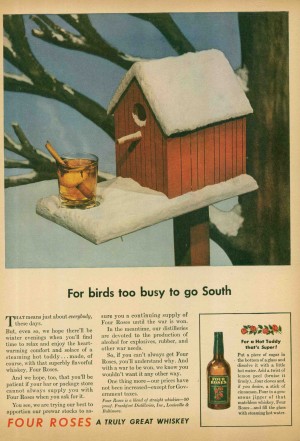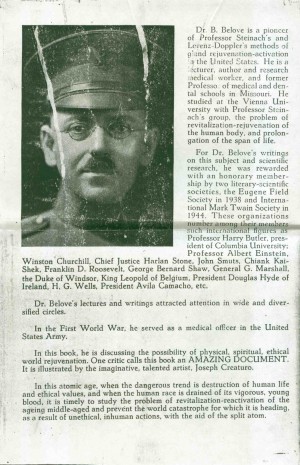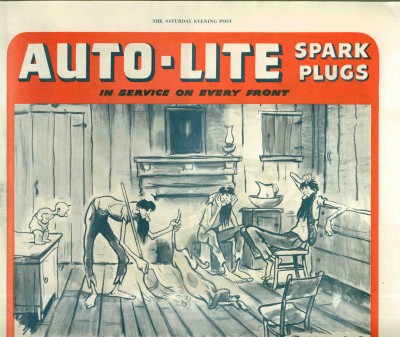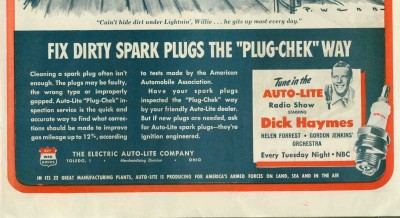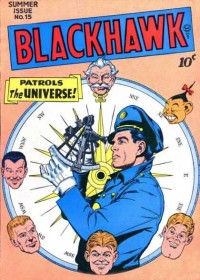1940s
Live and Let Live
Continuing our series of weird auto-safety films, we now examine one told completely through the medium of toys. This looks like it was a lot of fun for the creators to make.
Posted By: Paul - Thu Oct 23, 2008 -
Comments (2)
Category: Death, Education, Toys, Documentaries, 1940s, Cars
Follies of the Mad Men #38
Exactly how does one distinguish a male from a female dancing cigarette? I suspect this of being subliminal homosexual propaganda, since all the dancers look identical to me!
Posted By: Paul - Tue Oct 14, 2008 -
Comments (7)
Category: Business, Advertising, Tobacco and Smoking, 1940s, LGBT, Dance
Joan Avoids A Cold
As the weather becomes colder, let us all pay heed to our health, so that we may all stay well to attend the "Dutch Festival" of our choice.
Posted By: Paul - Mon Oct 06, 2008 -
Comments (5)
Category: Domestic, Education, Family, Children, Parents, Hygiene, Body Fluids, Parades and Festivals, Self-help Schemes, 1940s
Aristocrats of Fashion
Do you have enough Bemberg rayon clothes in your wardrobe? If not, watch this!(But be warned! Only a partial video remains to us down the ages. You'll never get to see the implied all-rayon wedding.)
Posted By: Paul - Tue Sep 30, 2008 -
Comments (3)
Category: Business, Advertising, Products, Fashion, 1930s, 1940s
Follies of the Mad Men #23
[From Newsweek for January 10 1944.]Surely nothing better evokes the confusing and guilty sensations associated with a "what's my name, and where did I leave my panties?" lost weekend better than a forgotten drink high atop a pole you shimmied up while looking for the bluebird of happiness.
Posted By: Paul - Thu Sep 04, 2008 -
Comments (3)
Category: Animals, Business, Advertising, Inebriation and Intoxicants, Corrections, 1940s, Weather
The Split Atom
Collecting weird books is one of my hobbies. And I'm not alone, as you can see from this site.Surely the novel depicted here, which I purchased a month ago at an SF convention, is museum-worthy. Amazingly in this day and age, I can't find any info about it or its author online. Thankfully, the previous owner xeroxed a page about the author and left it inside the book for me to reproduce here.
I can hardly wait to sit down with this one!
Posted By: Paul - Fri Aug 22, 2008 -
Comments (9)
Category: Eccentrics, Futurism, Literature, Books, Science Fiction, War, Weapons, 1940s
Follies of the Mad Men #13
[From Fortune for December 1945. Two scans, top and bottom.]
There is nothing spectacularly "weird" about this particular entry in our series, except that the artist is William Steig, the famed illustrator and author responsible, most notably in Hollywood terms, for Shrek. It's curious to see him turning his talents to advertising during his early career, as so many artists who later grew rich and famous once did.
Perhaps the true vestige of weirdness here, though, is the image of the proud boy wearing his Jughead cap. You can learn about the history of the Jughead beanie and how to make such a cap yourself at Juggie's Wikipedia page. Or perhaps you'd want to buy one readymade, either here or here.
But maybe you want to go for the entire Jughead look!
Posted By: Paul - Sun Aug 17, 2008 -
Comments (2)
Category: Business, Advertising, Products, Fashion, Hollywood, Literature, Books, Fantasy, Movies, Comics, 1940s
Follies of the Mad Men #9
[This image is from The Saturday Evening Post for May 5, 1945. As you can tell from the slightly mismatched borders, it's two separate scans, upper and lower, with the division just above the punchline caption. Excuse my impoverished Photoshop skills.]
Once upon a time, hillbillies were a powerful iconic staple of American life. But alas, no longer. Perhaps The Beverly Hillbillies was their dying gasp. Since then, PC guidelines no longer allow for such stereotypes, as the Abercrombie & Fitch folks found out a few years back, when they tried to market this T-shirt. And so our national mythology is a little drabber and duller.
Posted By: Paul - Sat Aug 09, 2008 -
Comments (5)
Category: Business, Advertising, Political Correctness, Regionalism, Television, 1940s
Julian Eltinge
Every election year, politicians seek to invoke a mythical Golden Age, when life was simpler and more wholesome. Take the Edwardian Era in America, for instance, when the moral fiber of the country was still unpolluted----and when a drag queen like Julian Eltinge was a top attraction in high society and popular culture alike.
Face it: life was never any different.
Posted By: Paul - Wed Aug 06, 2008 -
Comments (3)
Category: Celebrities, Eccentrics, Entertainment, Government, History, Historical Figure, Hollywood, Sexuality, Gender, Gender-bending, Men, Theater and Stage, Vaudeville, 1900s, 1910s, 1920s, 1930s, 1940s
Daring Polish Aviator—Times Two!
Synchronicity in the creative arts is pretty weird. The independent invention of very similar things. Charles Fort, one of the masters of all things weird, even had a term for it: "steam engine time." Fort's notion was that when an era was ripe, it called forth certain creations multiple times, without coordination among mere humans.I was reminded of this recently in a small way while watching the 1942 film TO BE OR NOT TO BE. In this film, Robert Stack plays a dashing Polish aviator named Lieut. Stanislav Sobinski.
What other fictional dashing Polish aviator premiered right at this time? None other than Blackhawk, who debuted in August of 1941.
Could it be a simple case of the Blackhawk comic influencing the scripter of To Be or Not to Be? Unlikely, given the short span between the debut of Blackhawk and the release of the Robert Stack film, which had to be in production for some time prior.
It's more likely that the plight of Poland under Hitler's invasion called forth the notion of a national hero. But why aviator? Just the romance of aerial combat, I suppose.
Here're pictures of Blackhawk and Stack in his role (leftmost figure, below) to compare. Stack is out of uniform in this shot, but when he's wearing his flying outfit, the resemblance to Blackhawk is uncanny.
Posted By: Paul - Sun Jul 13, 2008 -
Comments (11)
Category: Art, Comics, Celebrities, Decades, 1940s, Forteana, History, Historical Figure, Hollywood, Inventions, Movies, Synchronicity

| Who We Are |
|---|
| Alex Boese Alex is the creator and curator of the Museum of Hoaxes. He's also the author of various weird, non-fiction, science-themed books such as Elephants on Acid and Psychedelic Apes. Paul Di Filippo Paul has been paid to put weird ideas into fictional form for over thirty years, in his career as a noted science fiction writer. He has recently begun blogging on many curious topics with three fellow writers at The Inferior 4+1. Contact Us |

